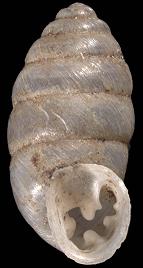Adaptation
Size
Compared to many other species in the genus Gastrocopta and
family Vertiginidae, G. armifera is massive with a
length up to 5mm and diameter of up to 2.6mm(Hubricht,
1972), it is one of the only snails of its kind that can be
readily spotted and picked up in the field (Carnegie,
2011). This large size can be both beneficial and harmful
to G. armifera. When plant life in its habitat is not
prosperous, G. armifera can use its large size to
overpower and prey on species of snail smaller than itself.
However, this large size also means that G. armifera is
much more visible to its predators such as salamanders and small
mammals (Discover, 2011).
Movement
Much like all other species in the Class Gastropoda, G.
armifera moves by sliding on its muscular foot. They creep
forward by progressive waves of contraction and expansion of a
ventral, muscular foot. Glands in the muscular foot secrete
slimy mucus that enables them to glide over rough surfaces (Martin,
2000).
Supercooling
G. armifera has an epiphragm, or a thin membrane that
covers the aperture during hibernation. This epiphragm aids
G. armifera in its unique and outstanding ability to
supercool, more so than any other land snail species found in
America (Riddle, 1988). This
ability to supercool, or tolerate cold temperatures, allows
G. armifera to survive harsh winters and move its northern
boundary further north. In some snails, G. armifera has
a secondary epiphragm that may cause its extraordinary ability
to supercool, as snails with an epiphragm have a significantly
higher ability to supercool than snails that do not form an
epiphragm (Ansart et al, 2002).
Radula
The Armed Snaggletooth also uses a radula; a rasping,
protrusible, tongue-like organ found in all mollusks except
bivalves. This radula is covered with as many as 250,00 teeth
that can scrape, pierce, tear, or cut particles of food. The
radula may also serve as a rasping file for carrying particles
in a continuous stream towards the digestive tract (Hickman
et al, 2007).
Lamellae
G. armifera, like all other species in the
genus Gastrocopta have multiple projections around the shell
aperturecall “lamellae”. These lamellae can be used as
protection or to help prevent water loss; both things very
important in smaller species of snails. The unique patterns of
the lamellae in the aperture are employed to distinguish species
and races within the Family Gastrocoptidae. The distinguishing
pattern for the G. armifera is a total of five of these “teeth,”
including a massive columellar lamella, and at top center, a
bifurcate lamella formed by the joining of the angular and
parietal lamellae (Carnegie, 2011).
The Empty Shell of G. armifera
(The lamellae can be clearly seen at the opening of the shell)

